Cost and Management Accounting Essay: Traditional Budgeting Analysis
VerifiedAdded on 2022/08/31
|14
|3666
|19
Essay
AI Summary
This essay critically examines the relevance of traditional budgeting and standard costing in the contemporary business environment. It begins by defining budgeting and its traditional methods, highlighting its importance in financial control, objective setting, and performance monitoring. The discussion explores the limitations of traditional budgeting, including its inflexibility and time-consuming nature, especially in dynamic business environments. The essay then delves into the reasons for the failure of traditional approaches, such as their lengthy processes and potential for manipulation. It introduces alternative approaches like activity-based budgeting, balanced scorecards, and zero-base budgeting. The essay also touches upon the 'beyond budgeting' and 'better budgeting' concepts, emphasizing the need for more flexible and adaptive financial management strategies. The essay references Jensen (2001) and Hope and Fraser (2003) to support its arguments and offers a comprehensive overview of the challenges and potential solutions in modern cost and management accounting.
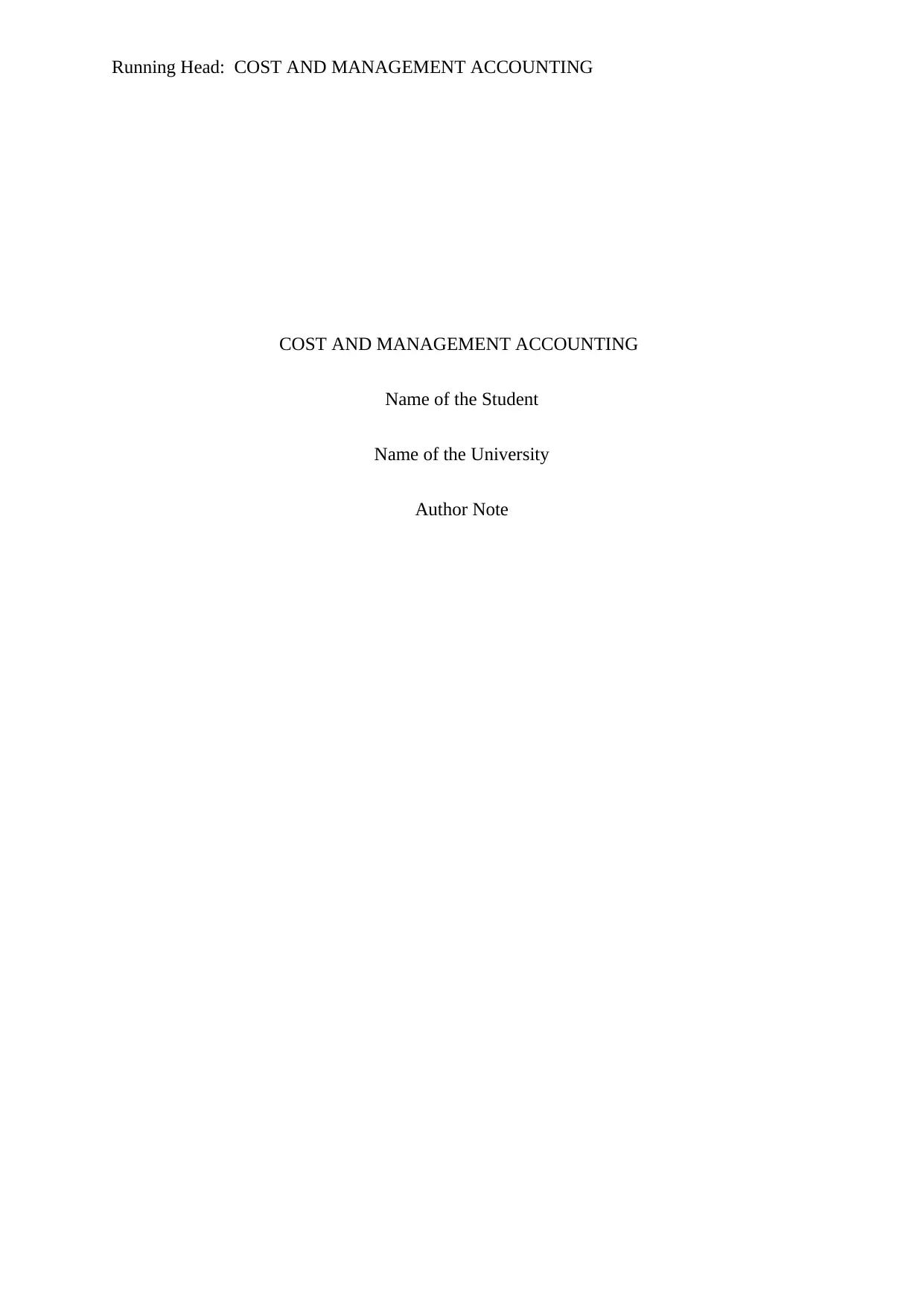
Running Head: COST AND MANAGEMENT ACCOUNTING
COST AND MANAGEMENT ACCOUNTING
Name of the Student
Name of the University
Author Note
COST AND MANAGEMENT ACCOUNTING
Name of the Student
Name of the University
Author Note
Paraphrase This Document
Need a fresh take? Get an instant paraphrase of this document with our AI Paraphraser
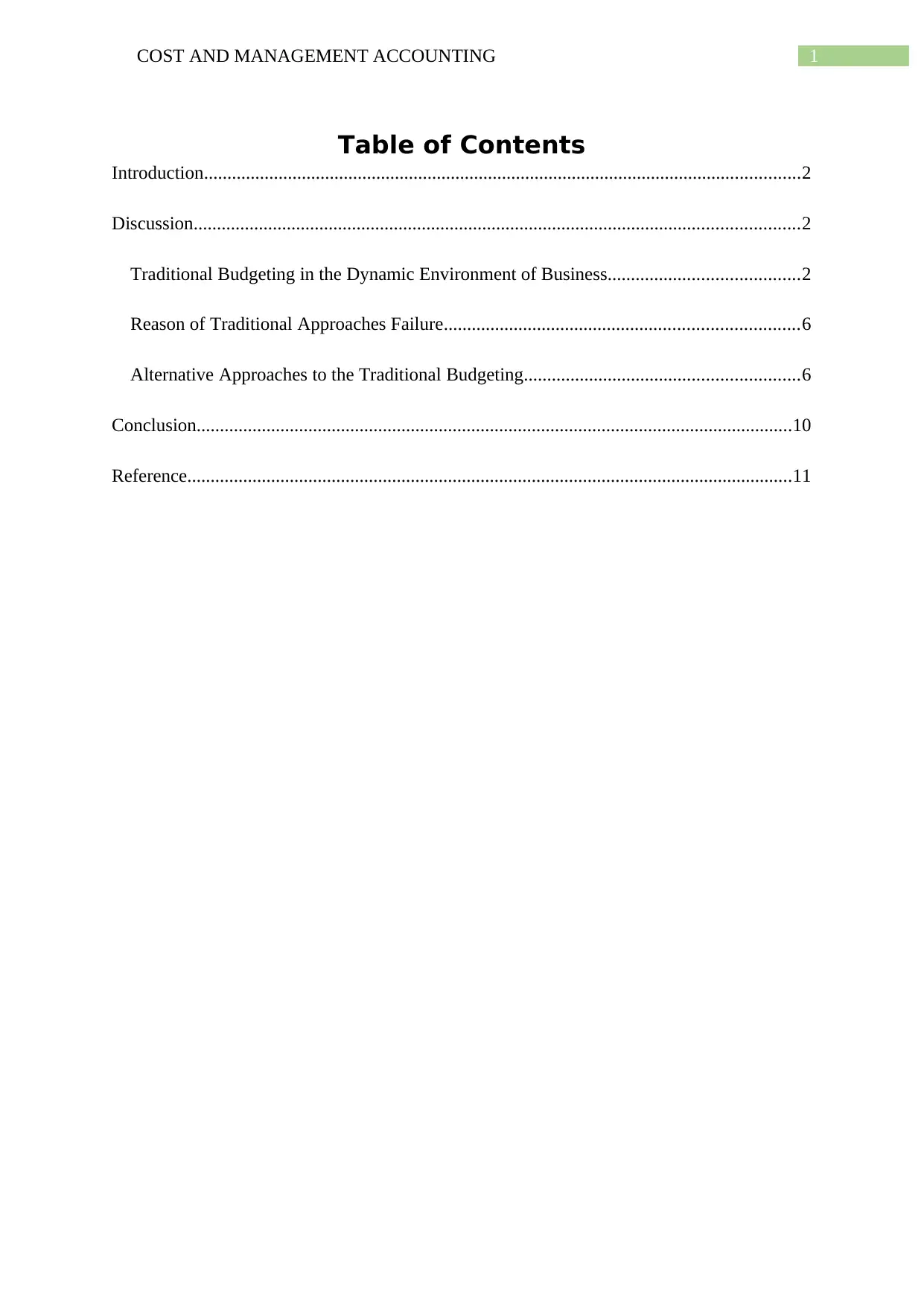
1COST AND MANAGEMENT ACCOUNTING
Table of Contents
Introduction................................................................................................................................2
Discussion..................................................................................................................................2
Traditional Budgeting in the Dynamic Environment of Business.........................................2
Reason of Traditional Approaches Failure............................................................................6
Alternative Approaches to the Traditional Budgeting...........................................................6
Conclusion................................................................................................................................10
Reference..................................................................................................................................11
Table of Contents
Introduction................................................................................................................................2
Discussion..................................................................................................................................2
Traditional Budgeting in the Dynamic Environment of Business.........................................2
Reason of Traditional Approaches Failure............................................................................6
Alternative Approaches to the Traditional Budgeting...........................................................6
Conclusion................................................................................................................................10
Reference..................................................................................................................................11
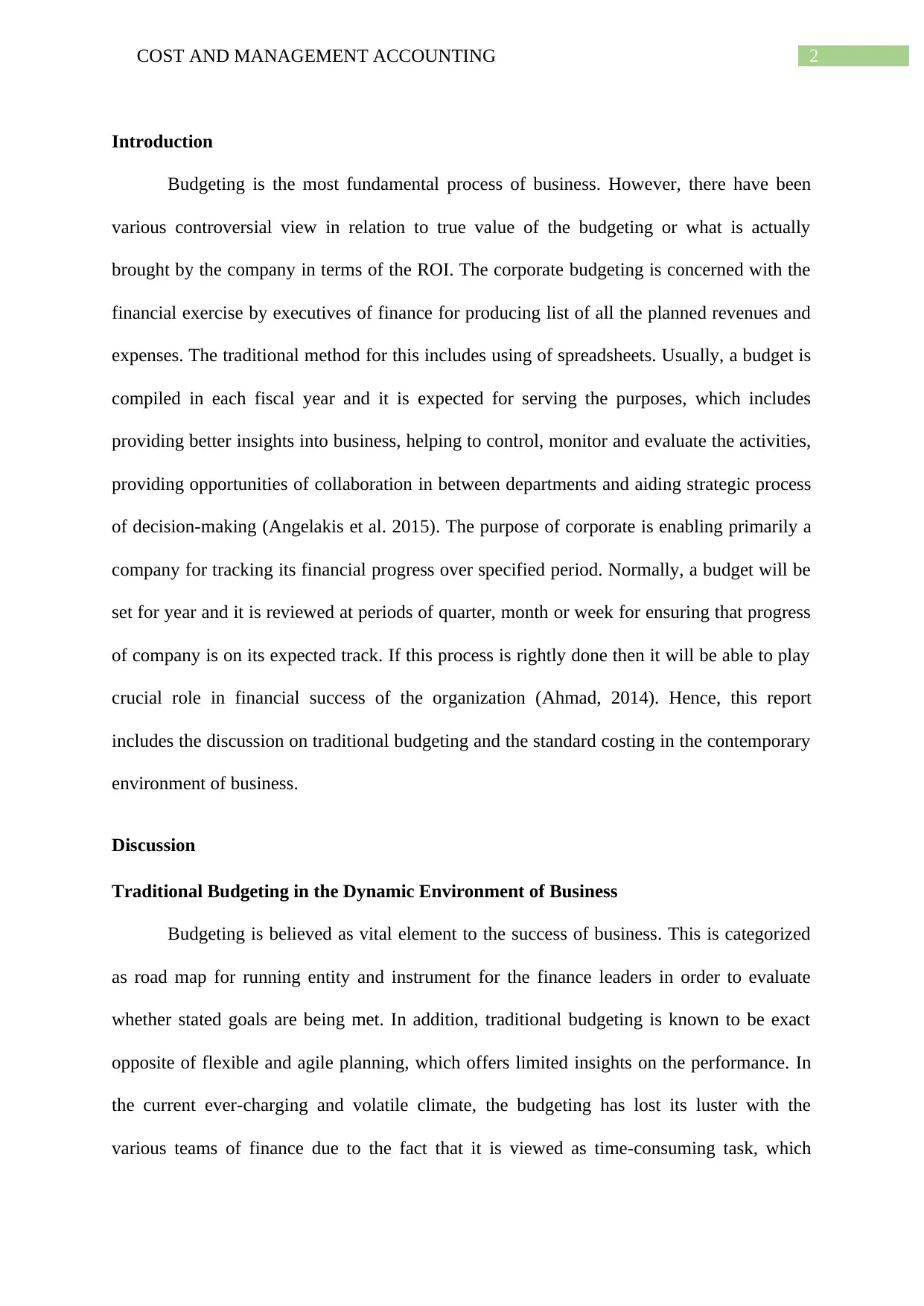
2COST AND MANAGEMENT ACCOUNTING
Introduction
Budgeting is the most fundamental process of business. However, there have been
various controversial view in relation to true value of the budgeting or what is actually
brought by the company in terms of the ROI. The corporate budgeting is concerned with the
financial exercise by executives of finance for producing list of all the planned revenues and
expenses. The traditional method for this includes using of spreadsheets. Usually, a budget is
compiled in each fiscal year and it is expected for serving the purposes, which includes
providing better insights into business, helping to control, monitor and evaluate the activities,
providing opportunities of collaboration in between departments and aiding strategic process
of decision-making (Angelakis et al. 2015). The purpose of corporate is enabling primarily a
company for tracking its financial progress over specified period. Normally, a budget will be
set for year and it is reviewed at periods of quarter, month or week for ensuring that progress
of company is on its expected track. If this process is rightly done then it will be able to play
crucial role in financial success of the organization (Ahmad, 2014). Hence, this report
includes the discussion on traditional budgeting and the standard costing in the contemporary
environment of business.
Discussion
Traditional Budgeting in the Dynamic Environment of Business
Budgeting is believed as vital element to the success of business. This is categorized
as road map for running entity and instrument for the finance leaders in order to evaluate
whether stated goals are being met. In addition, traditional budgeting is known to be exact
opposite of flexible and agile planning, which offers limited insights on the performance. In
the current ever-charging and volatile climate, the budgeting has lost its luster with the
various teams of finance due to the fact that it is viewed as time-consuming task, which
Introduction
Budgeting is the most fundamental process of business. However, there have been
various controversial view in relation to true value of the budgeting or what is actually
brought by the company in terms of the ROI. The corporate budgeting is concerned with the
financial exercise by executives of finance for producing list of all the planned revenues and
expenses. The traditional method for this includes using of spreadsheets. Usually, a budget is
compiled in each fiscal year and it is expected for serving the purposes, which includes
providing better insights into business, helping to control, monitor and evaluate the activities,
providing opportunities of collaboration in between departments and aiding strategic process
of decision-making (Angelakis et al. 2015). The purpose of corporate is enabling primarily a
company for tracking its financial progress over specified period. Normally, a budget will be
set for year and it is reviewed at periods of quarter, month or week for ensuring that progress
of company is on its expected track. If this process is rightly done then it will be able to play
crucial role in financial success of the organization (Ahmad, 2014). Hence, this report
includes the discussion on traditional budgeting and the standard costing in the contemporary
environment of business.
Discussion
Traditional Budgeting in the Dynamic Environment of Business
Budgeting is believed as vital element to the success of business. This is categorized
as road map for running entity and instrument for the finance leaders in order to evaluate
whether stated goals are being met. In addition, traditional budgeting is known to be exact
opposite of flexible and agile planning, which offers limited insights on the performance. In
the current ever-charging and volatile climate, the budgeting has lost its luster with the
various teams of finance due to the fact that it is viewed as time-consuming task, which
⊘ This is a preview!⊘
Do you want full access?
Subscribe today to unlock all pages.

Trusted by 1+ million students worldwide
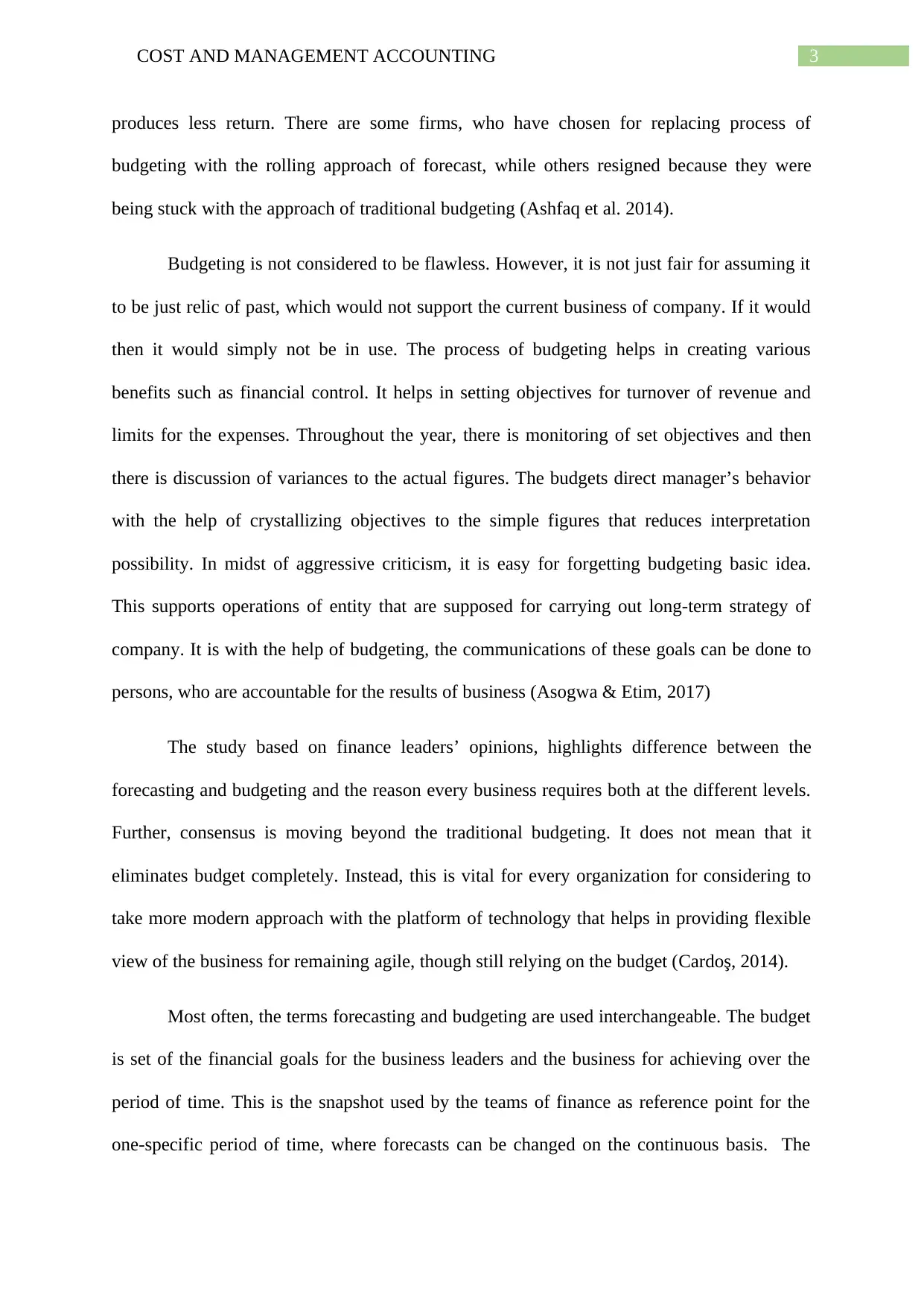
3COST AND MANAGEMENT ACCOUNTING
produces less return. There are some firms, who have chosen for replacing process of
budgeting with the rolling approach of forecast, while others resigned because they were
being stuck with the approach of traditional budgeting (Ashfaq et al. 2014).
Budgeting is not considered to be flawless. However, it is not just fair for assuming it
to be just relic of past, which would not support the current business of company. If it would
then it would simply not be in use. The process of budgeting helps in creating various
benefits such as financial control. It helps in setting objectives for turnover of revenue and
limits for the expenses. Throughout the year, there is monitoring of set objectives and then
there is discussion of variances to the actual figures. The budgets direct manager’s behavior
with the help of crystallizing objectives to the simple figures that reduces interpretation
possibility. In midst of aggressive criticism, it is easy for forgetting budgeting basic idea.
This supports operations of entity that are supposed for carrying out long-term strategy of
company. It is with the help of budgeting, the communications of these goals can be done to
persons, who are accountable for the results of business (Asogwa & Etim, 2017)
The study based on finance leaders’ opinions, highlights difference between the
forecasting and budgeting and the reason every business requires both at the different levels.
Further, consensus is moving beyond the traditional budgeting. It does not mean that it
eliminates budget completely. Instead, this is vital for every organization for considering to
take more modern approach with the platform of technology that helps in providing flexible
view of the business for remaining agile, though still relying on the budget (Cardoş, 2014).
Most often, the terms forecasting and budgeting are used interchangeable. The budget
is set of the financial goals for the business leaders and the business for achieving over the
period of time. This is the snapshot used by the teams of finance as reference point for the
one-specific period of time, where forecasts can be changed on the continuous basis. The
produces less return. There are some firms, who have chosen for replacing process of
budgeting with the rolling approach of forecast, while others resigned because they were
being stuck with the approach of traditional budgeting (Ashfaq et al. 2014).
Budgeting is not considered to be flawless. However, it is not just fair for assuming it
to be just relic of past, which would not support the current business of company. If it would
then it would simply not be in use. The process of budgeting helps in creating various
benefits such as financial control. It helps in setting objectives for turnover of revenue and
limits for the expenses. Throughout the year, there is monitoring of set objectives and then
there is discussion of variances to the actual figures. The budgets direct manager’s behavior
with the help of crystallizing objectives to the simple figures that reduces interpretation
possibility. In midst of aggressive criticism, it is easy for forgetting budgeting basic idea.
This supports operations of entity that are supposed for carrying out long-term strategy of
company. It is with the help of budgeting, the communications of these goals can be done to
persons, who are accountable for the results of business (Asogwa & Etim, 2017)
The study based on finance leaders’ opinions, highlights difference between the
forecasting and budgeting and the reason every business requires both at the different levels.
Further, consensus is moving beyond the traditional budgeting. It does not mean that it
eliminates budget completely. Instead, this is vital for every organization for considering to
take more modern approach with the platform of technology that helps in providing flexible
view of the business for remaining agile, though still relying on the budget (Cardoş, 2014).
Most often, the terms forecasting and budgeting are used interchangeable. The budget
is set of the financial goals for the business leaders and the business for achieving over the
period of time. This is the snapshot used by the teams of finance as reference point for the
one-specific period of time, where forecasts can be changed on the continuous basis. The
Paraphrase This Document
Need a fresh take? Get an instant paraphrase of this document with our AI Paraphraser
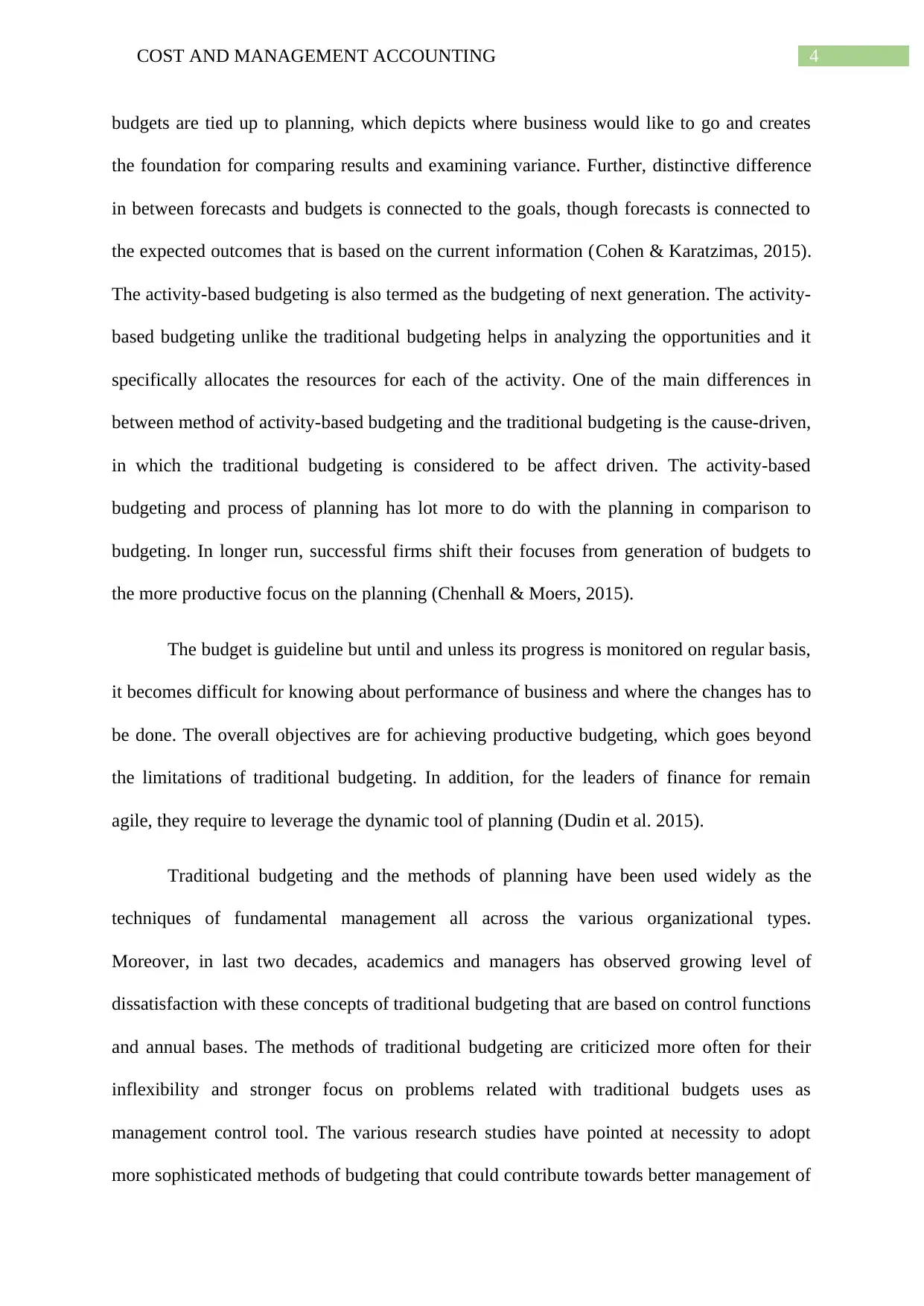
4COST AND MANAGEMENT ACCOUNTING
budgets are tied up to planning, which depicts where business would like to go and creates
the foundation for comparing results and examining variance. Further, distinctive difference
in between forecasts and budgets is connected to the goals, though forecasts is connected to
the expected outcomes that is based on the current information (Cohen & Karatzimas, 2015).
The activity-based budgeting is also termed as the budgeting of next generation. The activity-
based budgeting unlike the traditional budgeting helps in analyzing the opportunities and it
specifically allocates the resources for each of the activity. One of the main differences in
between method of activity-based budgeting and the traditional budgeting is the cause-driven,
in which the traditional budgeting is considered to be affect driven. The activity-based
budgeting and process of planning has lot more to do with the planning in comparison to
budgeting. In longer run, successful firms shift their focuses from generation of budgets to
the more productive focus on the planning (Chenhall & Moers, 2015).
The budget is guideline but until and unless its progress is monitored on regular basis,
it becomes difficult for knowing about performance of business and where the changes has to
be done. The overall objectives are for achieving productive budgeting, which goes beyond
the limitations of traditional budgeting. In addition, for the leaders of finance for remain
agile, they require to leverage the dynamic tool of planning (Dudin et al. 2015).
Traditional budgeting and the methods of planning have been used widely as the
techniques of fundamental management all across the various organizational types.
Moreover, in last two decades, academics and managers has observed growing level of
dissatisfaction with these concepts of traditional budgeting that are based on control functions
and annual bases. The methods of traditional budgeting are criticized more often for their
inflexibility and stronger focus on problems related with traditional budgets uses as
management control tool. The various research studies have pointed at necessity to adopt
more sophisticated methods of budgeting that could contribute towards better management of
budgets are tied up to planning, which depicts where business would like to go and creates
the foundation for comparing results and examining variance. Further, distinctive difference
in between forecasts and budgets is connected to the goals, though forecasts is connected to
the expected outcomes that is based on the current information (Cohen & Karatzimas, 2015).
The activity-based budgeting is also termed as the budgeting of next generation. The activity-
based budgeting unlike the traditional budgeting helps in analyzing the opportunities and it
specifically allocates the resources for each of the activity. One of the main differences in
between method of activity-based budgeting and the traditional budgeting is the cause-driven,
in which the traditional budgeting is considered to be affect driven. The activity-based
budgeting and process of planning has lot more to do with the planning in comparison to
budgeting. In longer run, successful firms shift their focuses from generation of budgets to
the more productive focus on the planning (Chenhall & Moers, 2015).
The budget is guideline but until and unless its progress is monitored on regular basis,
it becomes difficult for knowing about performance of business and where the changes has to
be done. The overall objectives are for achieving productive budgeting, which goes beyond
the limitations of traditional budgeting. In addition, for the leaders of finance for remain
agile, they require to leverage the dynamic tool of planning (Dudin et al. 2015).
Traditional budgeting and the methods of planning have been used widely as the
techniques of fundamental management all across the various organizational types.
Moreover, in last two decades, academics and managers has observed growing level of
dissatisfaction with these concepts of traditional budgeting that are based on control functions
and annual bases. The methods of traditional budgeting are criticized more often for their
inflexibility and stronger focus on problems related with traditional budgets uses as
management control tool. The various research studies have pointed at necessity to adopt
more sophisticated methods of budgeting that could contribute towards better management of
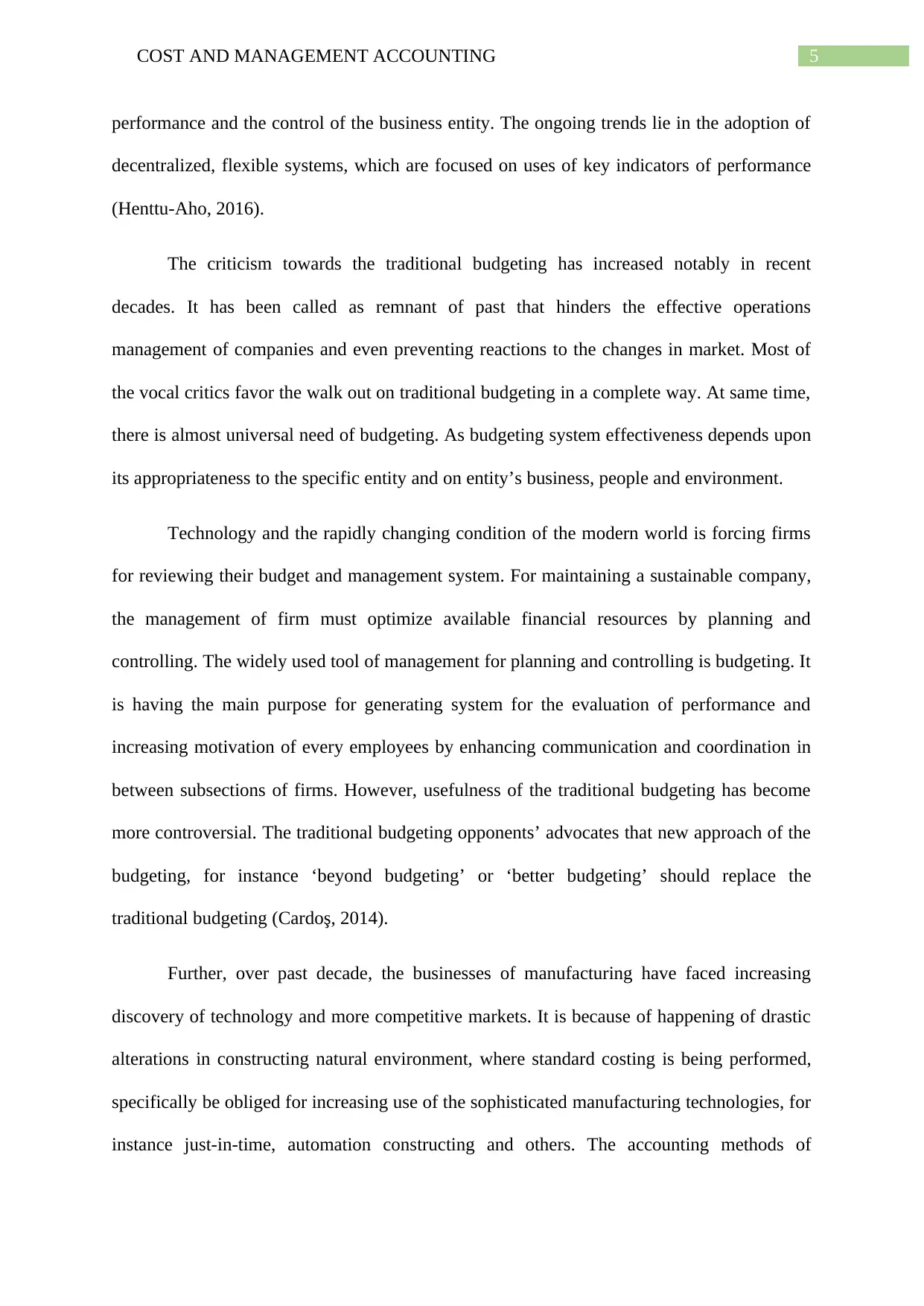
5COST AND MANAGEMENT ACCOUNTING
performance and the control of the business entity. The ongoing trends lie in the adoption of
decentralized, flexible systems, which are focused on uses of key indicators of performance
(Henttu-Aho, 2016).
The criticism towards the traditional budgeting has increased notably in recent
decades. It has been called as remnant of past that hinders the effective operations
management of companies and even preventing reactions to the changes in market. Most of
the vocal critics favor the walk out on traditional budgeting in a complete way. At same time,
there is almost universal need of budgeting. As budgeting system effectiveness depends upon
its appropriateness to the specific entity and on entity’s business, people and environment.
Technology and the rapidly changing condition of the modern world is forcing firms
for reviewing their budget and management system. For maintaining a sustainable company,
the management of firm must optimize available financial resources by planning and
controlling. The widely used tool of management for planning and controlling is budgeting. It
is having the main purpose for generating system for the evaluation of performance and
increasing motivation of every employees by enhancing communication and coordination in
between subsections of firms. However, usefulness of the traditional budgeting has become
more controversial. The traditional budgeting opponents’ advocates that new approach of the
budgeting, for instance ‘beyond budgeting’ or ‘better budgeting’ should replace the
traditional budgeting (Cardoş, 2014).
Further, over past decade, the businesses of manufacturing have faced increasing
discovery of technology and more competitive markets. It is because of happening of drastic
alterations in constructing natural environment, where standard costing is being performed,
specifically be obliged for increasing use of the sophisticated manufacturing technologies, for
instance just-in-time, automation constructing and others. The accounting methods of
performance and the control of the business entity. The ongoing trends lie in the adoption of
decentralized, flexible systems, which are focused on uses of key indicators of performance
(Henttu-Aho, 2016).
The criticism towards the traditional budgeting has increased notably in recent
decades. It has been called as remnant of past that hinders the effective operations
management of companies and even preventing reactions to the changes in market. Most of
the vocal critics favor the walk out on traditional budgeting in a complete way. At same time,
there is almost universal need of budgeting. As budgeting system effectiveness depends upon
its appropriateness to the specific entity and on entity’s business, people and environment.
Technology and the rapidly changing condition of the modern world is forcing firms
for reviewing their budget and management system. For maintaining a sustainable company,
the management of firm must optimize available financial resources by planning and
controlling. The widely used tool of management for planning and controlling is budgeting. It
is having the main purpose for generating system for the evaluation of performance and
increasing motivation of every employees by enhancing communication and coordination in
between subsections of firms. However, usefulness of the traditional budgeting has become
more controversial. The traditional budgeting opponents’ advocates that new approach of the
budgeting, for instance ‘beyond budgeting’ or ‘better budgeting’ should replace the
traditional budgeting (Cardoş, 2014).
Further, over past decade, the businesses of manufacturing have faced increasing
discovery of technology and more competitive markets. It is because of happening of drastic
alterations in constructing natural environment, where standard costing is being performed,
specifically be obliged for increasing use of the sophisticated manufacturing technologies, for
instance just-in-time, automation constructing and others. The accounting methods of
⊘ This is a preview!⊘
Do you want full access?
Subscribe today to unlock all pages.

Trusted by 1+ million students worldwide
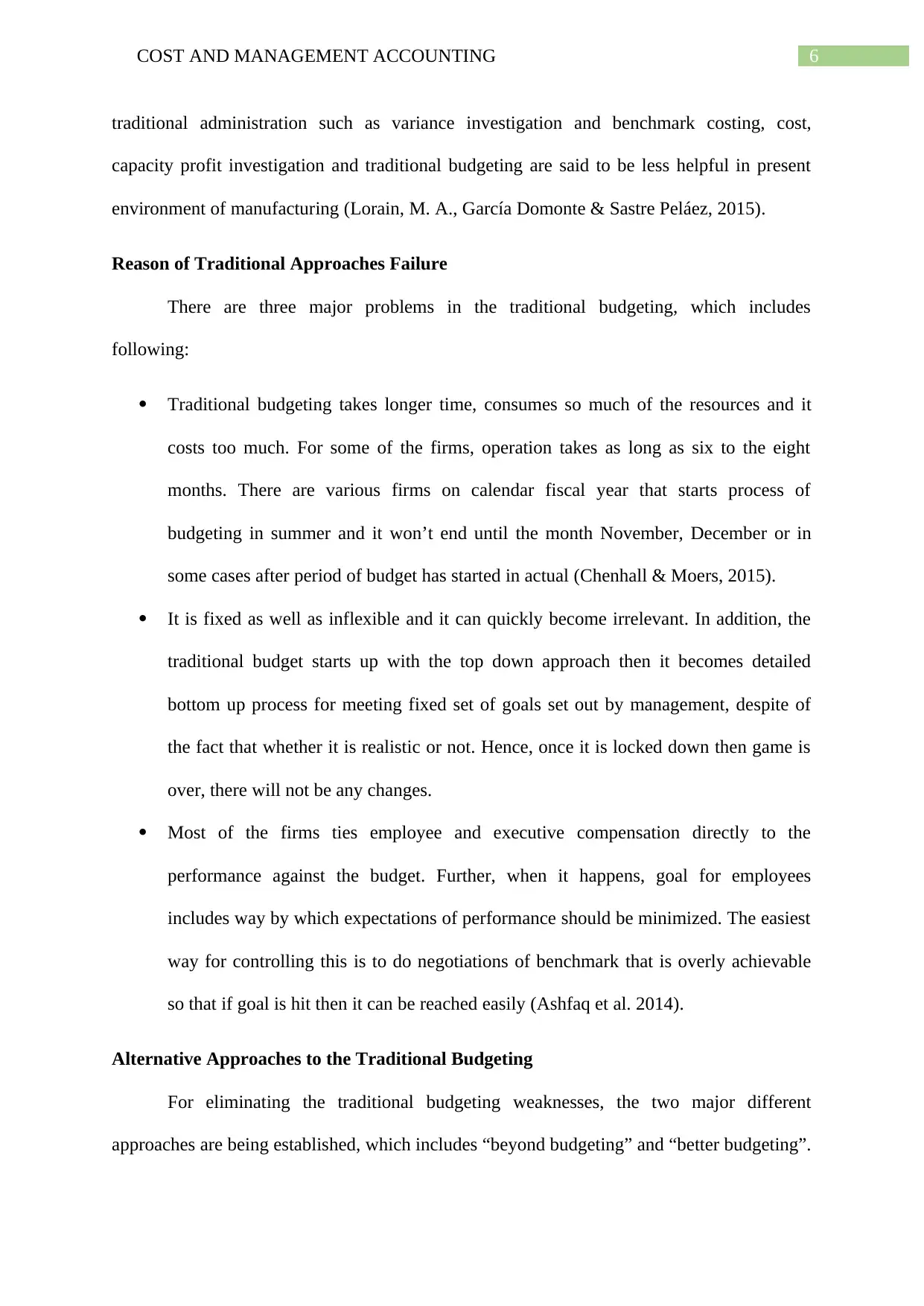
6COST AND MANAGEMENT ACCOUNTING
traditional administration such as variance investigation and benchmark costing, cost,
capacity profit investigation and traditional budgeting are said to be less helpful in present
environment of manufacturing (Lorain, M. A., García Domonte & Sastre Peláez, 2015).
Reason of Traditional Approaches Failure
There are three major problems in the traditional budgeting, which includes
following:
Traditional budgeting takes longer time, consumes so much of the resources and it
costs too much. For some of the firms, operation takes as long as six to the eight
months. There are various firms on calendar fiscal year that starts process of
budgeting in summer and it won’t end until the month November, December or in
some cases after period of budget has started in actual (Chenhall & Moers, 2015).
It is fixed as well as inflexible and it can quickly become irrelevant. In addition, the
traditional budget starts up with the top down approach then it becomes detailed
bottom up process for meeting fixed set of goals set out by management, despite of
the fact that whether it is realistic or not. Hence, once it is locked down then game is
over, there will not be any changes.
Most of the firms ties employee and executive compensation directly to the
performance against the budget. Further, when it happens, goal for employees
includes way by which expectations of performance should be minimized. The easiest
way for controlling this is to do negotiations of benchmark that is overly achievable
so that if goal is hit then it can be reached easily (Ashfaq et al. 2014).
Alternative Approaches to the Traditional Budgeting
For eliminating the traditional budgeting weaknesses, the two major different
approaches are being established, which includes “beyond budgeting” and “better budgeting”.
traditional administration such as variance investigation and benchmark costing, cost,
capacity profit investigation and traditional budgeting are said to be less helpful in present
environment of manufacturing (Lorain, M. A., García Domonte & Sastre Peláez, 2015).
Reason of Traditional Approaches Failure
There are three major problems in the traditional budgeting, which includes
following:
Traditional budgeting takes longer time, consumes so much of the resources and it
costs too much. For some of the firms, operation takes as long as six to the eight
months. There are various firms on calendar fiscal year that starts process of
budgeting in summer and it won’t end until the month November, December or in
some cases after period of budget has started in actual (Chenhall & Moers, 2015).
It is fixed as well as inflexible and it can quickly become irrelevant. In addition, the
traditional budget starts up with the top down approach then it becomes detailed
bottom up process for meeting fixed set of goals set out by management, despite of
the fact that whether it is realistic or not. Hence, once it is locked down then game is
over, there will not be any changes.
Most of the firms ties employee and executive compensation directly to the
performance against the budget. Further, when it happens, goal for employees
includes way by which expectations of performance should be minimized. The easiest
way for controlling this is to do negotiations of benchmark that is overly achievable
so that if goal is hit then it can be reached easily (Ashfaq et al. 2014).
Alternative Approaches to the Traditional Budgeting
For eliminating the traditional budgeting weaknesses, the two major different
approaches are being established, which includes “beyond budgeting” and “better budgeting”.
Paraphrase This Document
Need a fresh take? Get an instant paraphrase of this document with our AI Paraphraser
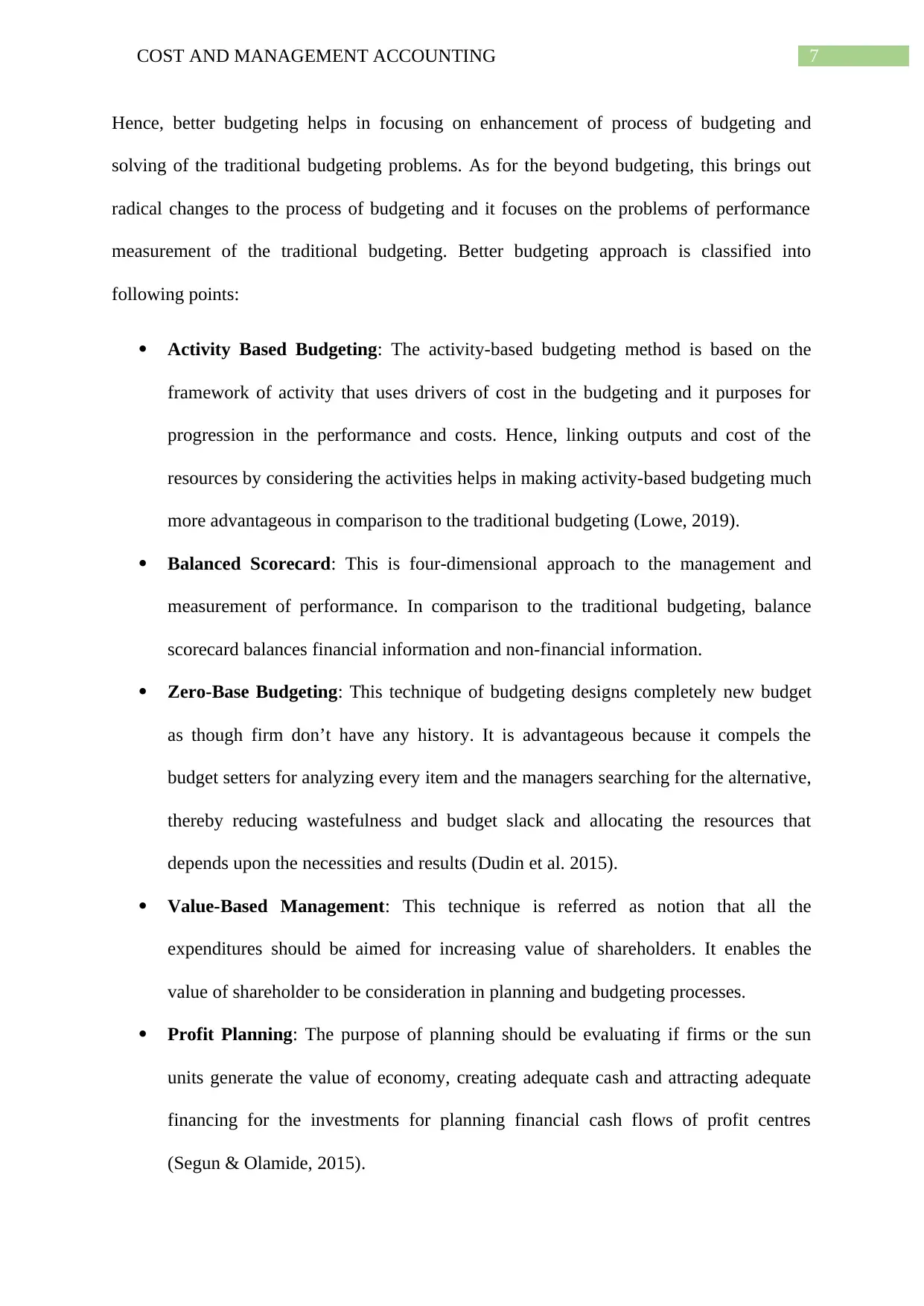
7COST AND MANAGEMENT ACCOUNTING
Hence, better budgeting helps in focusing on enhancement of process of budgeting and
solving of the traditional budgeting problems. As for the beyond budgeting, this brings out
radical changes to the process of budgeting and it focuses on the problems of performance
measurement of the traditional budgeting. Better budgeting approach is classified into
following points:
Activity Based Budgeting: The activity-based budgeting method is based on the
framework of activity that uses drivers of cost in the budgeting and it purposes for
progression in the performance and costs. Hence, linking outputs and cost of the
resources by considering the activities helps in making activity-based budgeting much
more advantageous in comparison to the traditional budgeting (Lowe, 2019).
Balanced Scorecard: This is four-dimensional approach to the management and
measurement of performance. In comparison to the traditional budgeting, balance
scorecard balances financial information and non-financial information.
Zero-Base Budgeting: This technique of budgeting designs completely new budget
as though firm don’t have any history. It is advantageous because it compels the
budget setters for analyzing every item and the managers searching for the alternative,
thereby reducing wastefulness and budget slack and allocating the resources that
depends upon the necessities and results (Dudin et al. 2015).
Value-Based Management: This technique is referred as notion that all the
expenditures should be aimed for increasing value of shareholders. It enables the
value of shareholder to be consideration in planning and budgeting processes.
Profit Planning: The purpose of planning should be evaluating if firms or the sun
units generate the value of economy, creating adequate cash and attracting adequate
financing for the investments for planning financial cash flows of profit centres
(Segun & Olamide, 2015).
Hence, better budgeting helps in focusing on enhancement of process of budgeting and
solving of the traditional budgeting problems. As for the beyond budgeting, this brings out
radical changes to the process of budgeting and it focuses on the problems of performance
measurement of the traditional budgeting. Better budgeting approach is classified into
following points:
Activity Based Budgeting: The activity-based budgeting method is based on the
framework of activity that uses drivers of cost in the budgeting and it purposes for
progression in the performance and costs. Hence, linking outputs and cost of the
resources by considering the activities helps in making activity-based budgeting much
more advantageous in comparison to the traditional budgeting (Lowe, 2019).
Balanced Scorecard: This is four-dimensional approach to the management and
measurement of performance. In comparison to the traditional budgeting, balance
scorecard balances financial information and non-financial information.
Zero-Base Budgeting: This technique of budgeting designs completely new budget
as though firm don’t have any history. It is advantageous because it compels the
budget setters for analyzing every item and the managers searching for the alternative,
thereby reducing wastefulness and budget slack and allocating the resources that
depends upon the necessities and results (Dudin et al. 2015).
Value-Based Management: This technique is referred as notion that all the
expenditures should be aimed for increasing value of shareholders. It enables the
value of shareholder to be consideration in planning and budgeting processes.
Profit Planning: The purpose of planning should be evaluating if firms or the sun
units generate the value of economy, creating adequate cash and attracting adequate
financing for the investments for planning financial cash flows of profit centres
(Segun & Olamide, 2015).
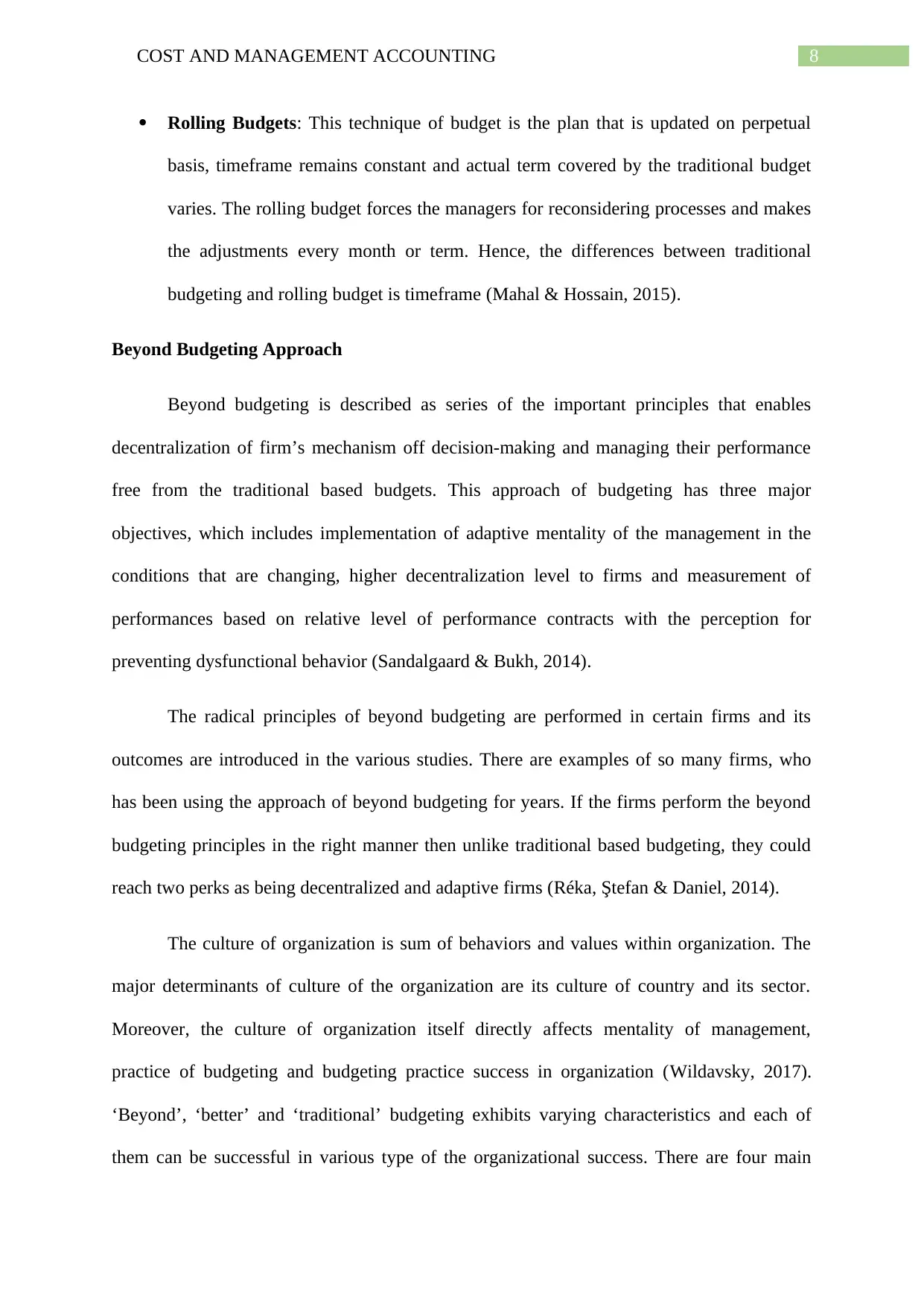
8COST AND MANAGEMENT ACCOUNTING
Rolling Budgets: This technique of budget is the plan that is updated on perpetual
basis, timeframe remains constant and actual term covered by the traditional budget
varies. The rolling budget forces the managers for reconsidering processes and makes
the adjustments every month or term. Hence, the differences between traditional
budgeting and rolling budget is timeframe (Mahal & Hossain, 2015).
Beyond Budgeting Approach
Beyond budgeting is described as series of the important principles that enables
decentralization of firm’s mechanism off decision-making and managing their performance
free from the traditional based budgets. This approach of budgeting has three major
objectives, which includes implementation of adaptive mentality of the management in the
conditions that are changing, higher decentralization level to firms and measurement of
performances based on relative level of performance contracts with the perception for
preventing dysfunctional behavior (Sandalgaard & Bukh, 2014).
The radical principles of beyond budgeting are performed in certain firms and its
outcomes are introduced in the various studies. There are examples of so many firms, who
has been using the approach of beyond budgeting for years. If the firms perform the beyond
budgeting principles in the right manner then unlike traditional based budgeting, they could
reach two perks as being decentralized and adaptive firms (Réka, Ştefan & Daniel, 2014).
The culture of organization is sum of behaviors and values within organization. The
major determinants of culture of the organization are its culture of country and its sector.
Moreover, the culture of organization itself directly affects mentality of management,
practice of budgeting and budgeting practice success in organization (Wildavsky, 2017).
‘Beyond’, ‘better’ and ‘traditional’ budgeting exhibits varying characteristics and each of
them can be successful in various type of the organizational success. There are four main
Rolling Budgets: This technique of budget is the plan that is updated on perpetual
basis, timeframe remains constant and actual term covered by the traditional budget
varies. The rolling budget forces the managers for reconsidering processes and makes
the adjustments every month or term. Hence, the differences between traditional
budgeting and rolling budget is timeframe (Mahal & Hossain, 2015).
Beyond Budgeting Approach
Beyond budgeting is described as series of the important principles that enables
decentralization of firm’s mechanism off decision-making and managing their performance
free from the traditional based budgets. This approach of budgeting has three major
objectives, which includes implementation of adaptive mentality of the management in the
conditions that are changing, higher decentralization level to firms and measurement of
performances based on relative level of performance contracts with the perception for
preventing dysfunctional behavior (Sandalgaard & Bukh, 2014).
The radical principles of beyond budgeting are performed in certain firms and its
outcomes are introduced in the various studies. There are examples of so many firms, who
has been using the approach of beyond budgeting for years. If the firms perform the beyond
budgeting principles in the right manner then unlike traditional based budgeting, they could
reach two perks as being decentralized and adaptive firms (Réka, Ştefan & Daniel, 2014).
The culture of organization is sum of behaviors and values within organization. The
major determinants of culture of the organization are its culture of country and its sector.
Moreover, the culture of organization itself directly affects mentality of management,
practice of budgeting and budgeting practice success in organization (Wildavsky, 2017).
‘Beyond’, ‘better’ and ‘traditional’ budgeting exhibits varying characteristics and each of
them can be successful in various type of the organizational success. There are four main
⊘ This is a preview!⊘
Do you want full access?
Subscribe today to unlock all pages.

Trusted by 1+ million students worldwide
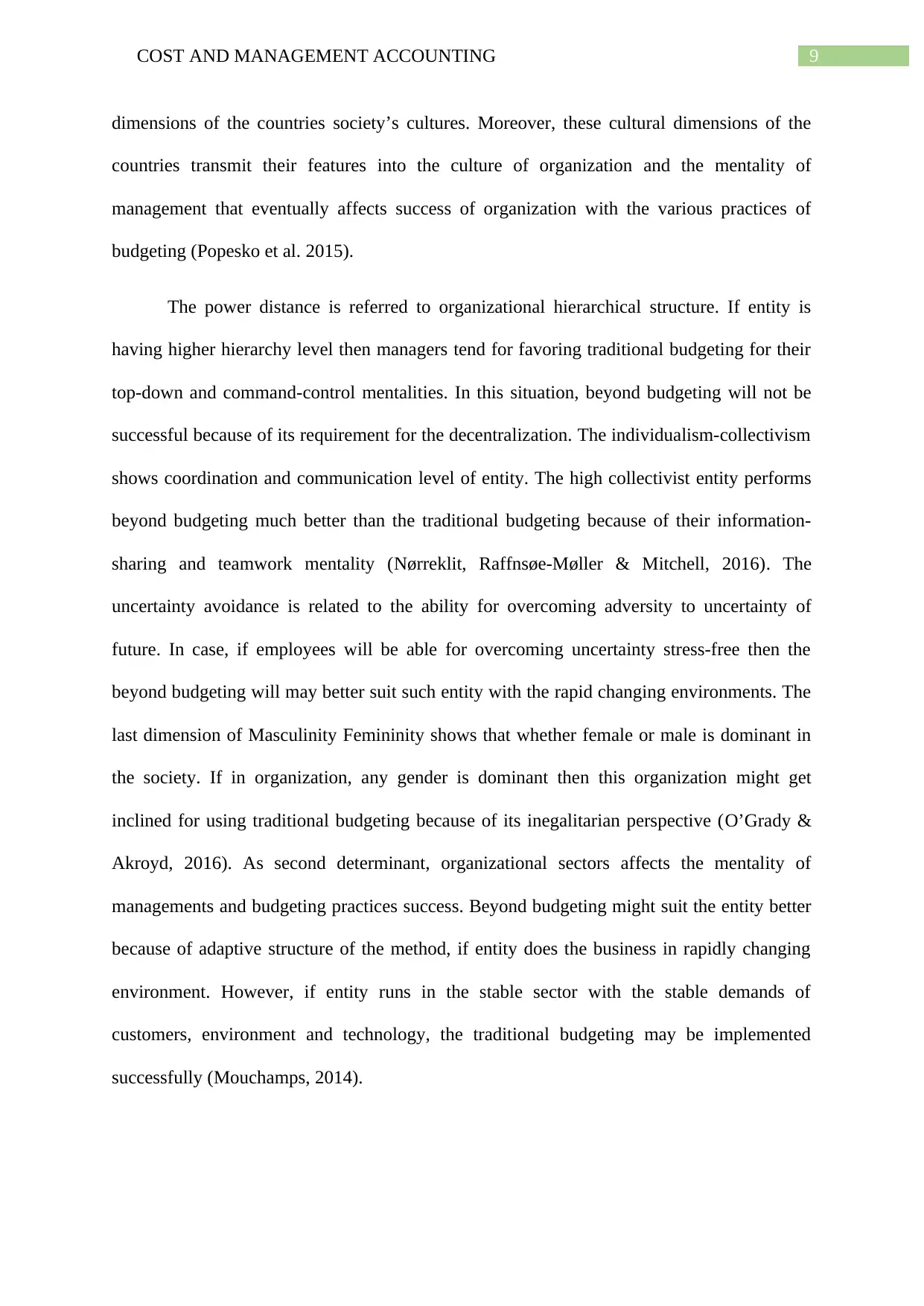
9COST AND MANAGEMENT ACCOUNTING
dimensions of the countries society’s cultures. Moreover, these cultural dimensions of the
countries transmit their features into the culture of organization and the mentality of
management that eventually affects success of organization with the various practices of
budgeting (Popesko et al. 2015).
The power distance is referred to organizational hierarchical structure. If entity is
having higher hierarchy level then managers tend for favoring traditional budgeting for their
top-down and command-control mentalities. In this situation, beyond budgeting will not be
successful because of its requirement for the decentralization. The individualism-collectivism
shows coordination and communication level of entity. The high collectivist entity performs
beyond budgeting much better than the traditional budgeting because of their information-
sharing and teamwork mentality (Nørreklit, Raffnsøe-Møller & Mitchell, 2016). The
uncertainty avoidance is related to the ability for overcoming adversity to uncertainty of
future. In case, if employees will be able for overcoming uncertainty stress-free then the
beyond budgeting will may better suit such entity with the rapid changing environments. The
last dimension of Masculinity Femininity shows that whether female or male is dominant in
the society. If in organization, any gender is dominant then this organization might get
inclined for using traditional budgeting because of its inegalitarian perspective (O’Grady &
Akroyd, 2016). As second determinant, organizational sectors affects the mentality of
managements and budgeting practices success. Beyond budgeting might suit the entity better
because of adaptive structure of the method, if entity does the business in rapidly changing
environment. However, if entity runs in the stable sector with the stable demands of
customers, environment and technology, the traditional budgeting may be implemented
successfully (Mouchamps, 2014).
dimensions of the countries society’s cultures. Moreover, these cultural dimensions of the
countries transmit their features into the culture of organization and the mentality of
management that eventually affects success of organization with the various practices of
budgeting (Popesko et al. 2015).
The power distance is referred to organizational hierarchical structure. If entity is
having higher hierarchy level then managers tend for favoring traditional budgeting for their
top-down and command-control mentalities. In this situation, beyond budgeting will not be
successful because of its requirement for the decentralization. The individualism-collectivism
shows coordination and communication level of entity. The high collectivist entity performs
beyond budgeting much better than the traditional budgeting because of their information-
sharing and teamwork mentality (Nørreklit, Raffnsøe-Møller & Mitchell, 2016). The
uncertainty avoidance is related to the ability for overcoming adversity to uncertainty of
future. In case, if employees will be able for overcoming uncertainty stress-free then the
beyond budgeting will may better suit such entity with the rapid changing environments. The
last dimension of Masculinity Femininity shows that whether female or male is dominant in
the society. If in organization, any gender is dominant then this organization might get
inclined for using traditional budgeting because of its inegalitarian perspective (O’Grady &
Akroyd, 2016). As second determinant, organizational sectors affects the mentality of
managements and budgeting practices success. Beyond budgeting might suit the entity better
because of adaptive structure of the method, if entity does the business in rapidly changing
environment. However, if entity runs in the stable sector with the stable demands of
customers, environment and technology, the traditional budgeting may be implemented
successfully (Mouchamps, 2014).
Paraphrase This Document
Need a fresh take? Get an instant paraphrase of this document with our AI Paraphraser
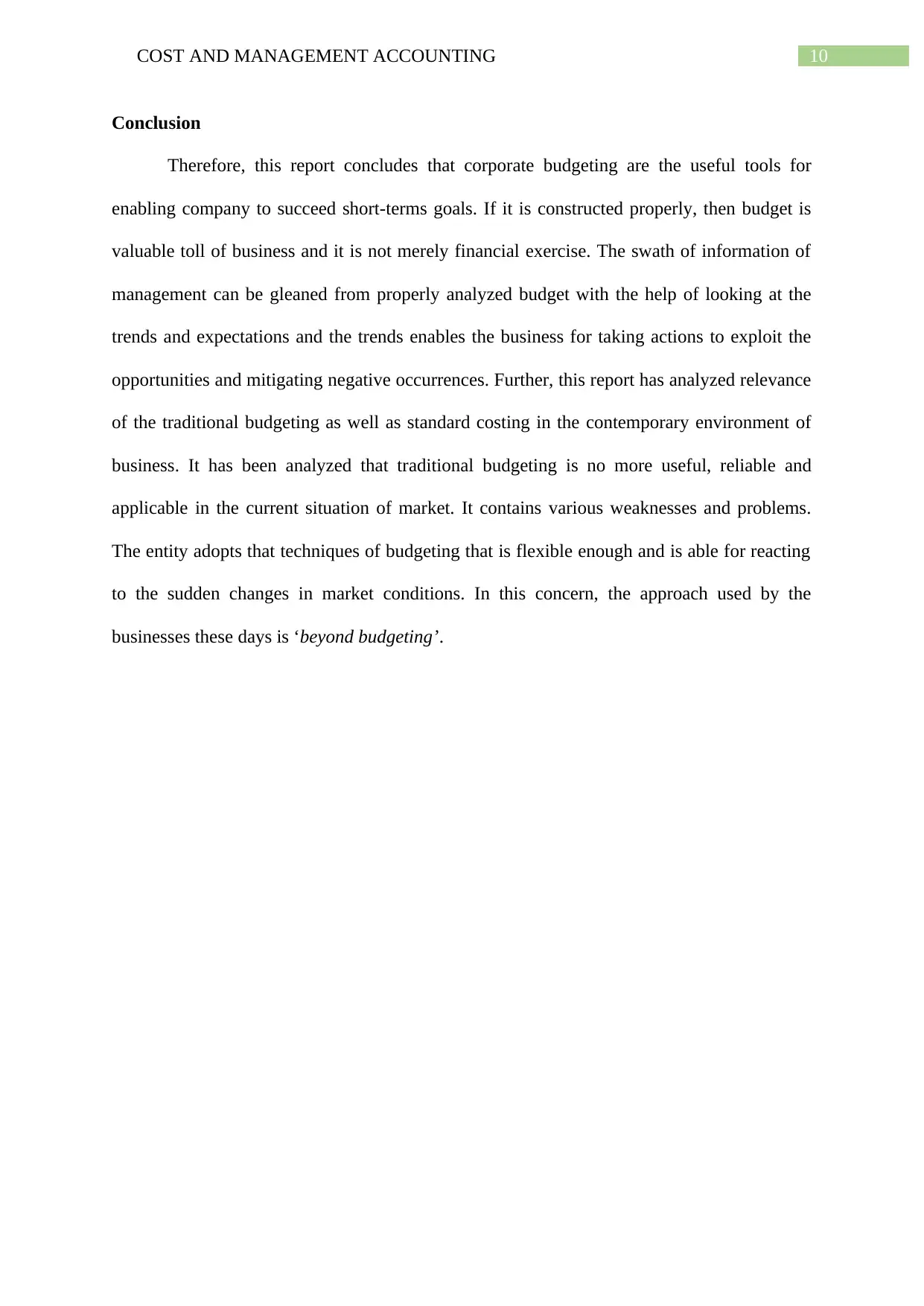
10COST AND MANAGEMENT ACCOUNTING
Conclusion
Therefore, this report concludes that corporate budgeting are the useful tools for
enabling company to succeed short-terms goals. If it is constructed properly, then budget is
valuable toll of business and it is not merely financial exercise. The swath of information of
management can be gleaned from properly analyzed budget with the help of looking at the
trends and expectations and the trends enables the business for taking actions to exploit the
opportunities and mitigating negative occurrences. Further, this report has analyzed relevance
of the traditional budgeting as well as standard costing in the contemporary environment of
business. It has been analyzed that traditional budgeting is no more useful, reliable and
applicable in the current situation of market. It contains various weaknesses and problems.
The entity adopts that techniques of budgeting that is flexible enough and is able for reacting
to the sudden changes in market conditions. In this concern, the approach used by the
businesses these days is ‘beyond budgeting’.
Conclusion
Therefore, this report concludes that corporate budgeting are the useful tools for
enabling company to succeed short-terms goals. If it is constructed properly, then budget is
valuable toll of business and it is not merely financial exercise. The swath of information of
management can be gleaned from properly analyzed budget with the help of looking at the
trends and expectations and the trends enables the business for taking actions to exploit the
opportunities and mitigating negative occurrences. Further, this report has analyzed relevance
of the traditional budgeting as well as standard costing in the contemporary environment of
business. It has been analyzed that traditional budgeting is no more useful, reliable and
applicable in the current situation of market. It contains various weaknesses and problems.
The entity adopts that techniques of budgeting that is flexible enough and is able for reacting
to the sudden changes in market conditions. In this concern, the approach used by the
businesses these days is ‘beyond budgeting’.
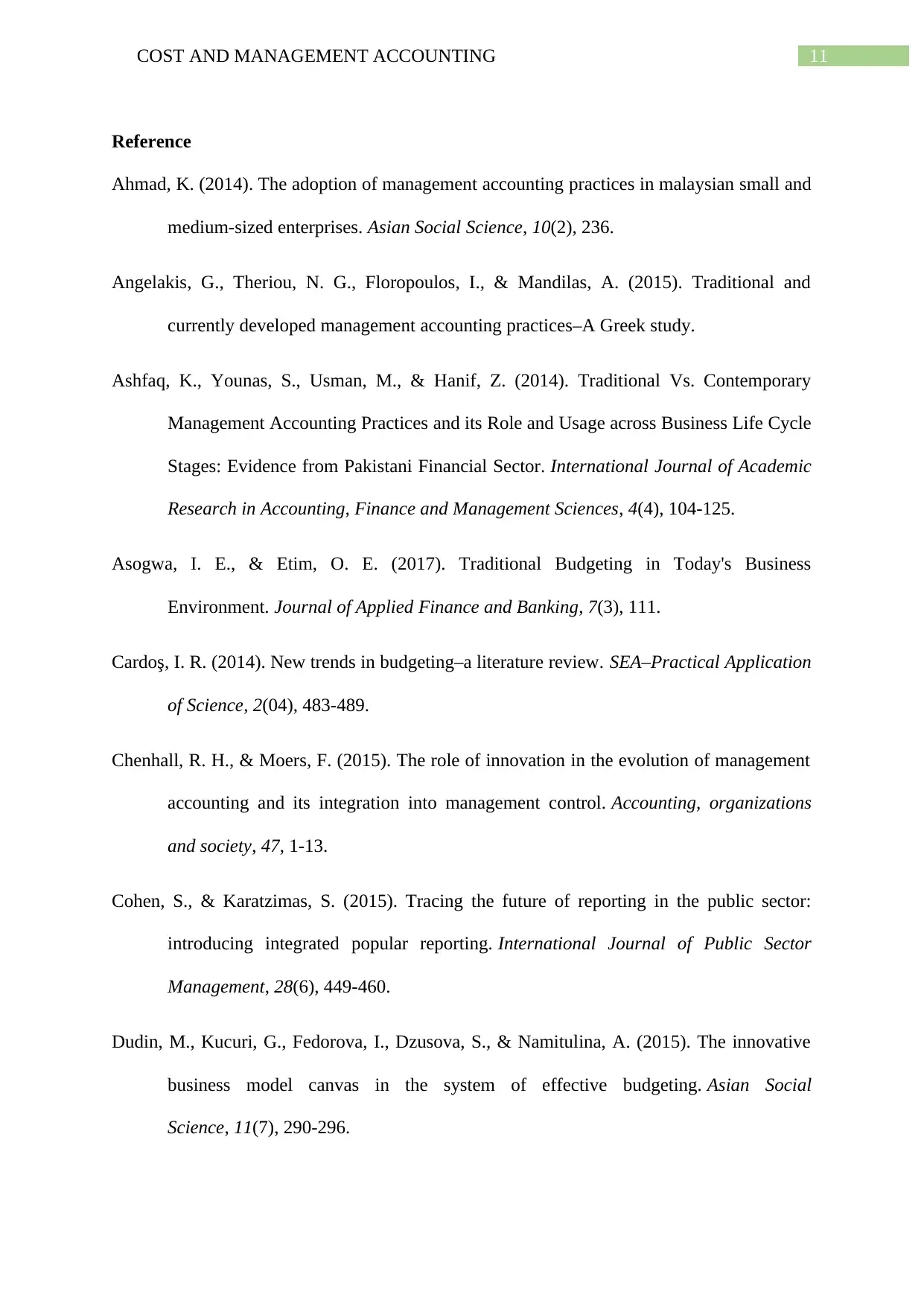
11COST AND MANAGEMENT ACCOUNTING
Reference
Ahmad, K. (2014). The adoption of management accounting practices in malaysian small and
medium-sized enterprises. Asian Social Science, 10(2), 236.
Angelakis, G., Theriou, N. G., Floropoulos, I., & Mandilas, A. (2015). Traditional and
currently developed management accounting practices–A Greek study.
Ashfaq, K., Younas, S., Usman, M., & Hanif, Z. (2014). Traditional Vs. Contemporary
Management Accounting Practices and its Role and Usage across Business Life Cycle
Stages: Evidence from Pakistani Financial Sector. International Journal of Academic
Research in Accounting, Finance and Management Sciences, 4(4), 104-125.
Asogwa, I. E., & Etim, O. E. (2017). Traditional Budgeting in Today's Business
Environment. Journal of Applied Finance and Banking, 7(3), 111.
Cardoş, I. R. (2014). New trends in budgeting–a literature review. SEA–Practical Application
of Science, 2(04), 483-489.
Chenhall, R. H., & Moers, F. (2015). The role of innovation in the evolution of management
accounting and its integration into management control. Accounting, organizations
and society, 47, 1-13.
Cohen, S., & Karatzimas, S. (2015). Tracing the future of reporting in the public sector:
introducing integrated popular reporting. International Journal of Public Sector
Management, 28(6), 449-460.
Dudin, M., Kucuri, G., Fedorova, I., Dzusova, S., & Namitulina, A. (2015). The innovative
business model canvas in the system of effective budgeting. Asian Social
Science, 11(7), 290-296.
Reference
Ahmad, K. (2014). The adoption of management accounting practices in malaysian small and
medium-sized enterprises. Asian Social Science, 10(2), 236.
Angelakis, G., Theriou, N. G., Floropoulos, I., & Mandilas, A. (2015). Traditional and
currently developed management accounting practices–A Greek study.
Ashfaq, K., Younas, S., Usman, M., & Hanif, Z. (2014). Traditional Vs. Contemporary
Management Accounting Practices and its Role and Usage across Business Life Cycle
Stages: Evidence from Pakistani Financial Sector. International Journal of Academic
Research in Accounting, Finance and Management Sciences, 4(4), 104-125.
Asogwa, I. E., & Etim, O. E. (2017). Traditional Budgeting in Today's Business
Environment. Journal of Applied Finance and Banking, 7(3), 111.
Cardoş, I. R. (2014). New trends in budgeting–a literature review. SEA–Practical Application
of Science, 2(04), 483-489.
Chenhall, R. H., & Moers, F. (2015). The role of innovation in the evolution of management
accounting and its integration into management control. Accounting, organizations
and society, 47, 1-13.
Cohen, S., & Karatzimas, S. (2015). Tracing the future of reporting in the public sector:
introducing integrated popular reporting. International Journal of Public Sector
Management, 28(6), 449-460.
Dudin, M., Kucuri, G., Fedorova, I., Dzusova, S., & Namitulina, A. (2015). The innovative
business model canvas in the system of effective budgeting. Asian Social
Science, 11(7), 290-296.
⊘ This is a preview!⊘
Do you want full access?
Subscribe today to unlock all pages.

Trusted by 1+ million students worldwide
1 out of 14
Related Documents
Your All-in-One AI-Powered Toolkit for Academic Success.
+13062052269
info@desklib.com
Available 24*7 on WhatsApp / Email
![[object Object]](/_next/static/media/star-bottom.7253800d.svg)
Unlock your academic potential
Copyright © 2020–2025 A2Z Services. All Rights Reserved. Developed and managed by ZUCOL.





